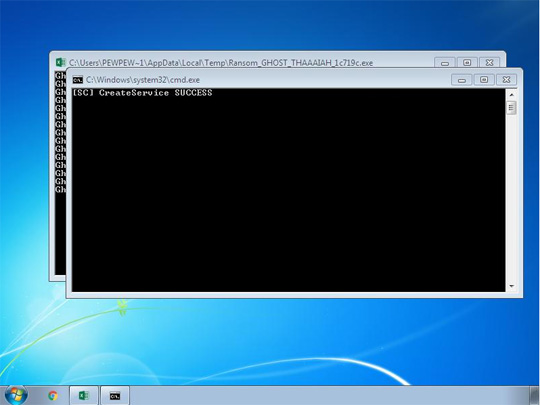RANSOM_GHOST.THAAAIAH
Trojan:Win32/Occamy.C (Microsoft), MSIL/Filecoder.QK (ESET-NOD32)
Windows


Threat Type: Ransomware
Destructiveness: No
Encrypted: No
In the wild: Yes
OVERVIEW
This Ransomware arrives on a system as a file dropped by other malware or as a file downloaded unknowingly by users when visiting malicious sites.
It encrypts files found in specific folders.
TECHNICAL DETAILS
Arrival Details
This Ransomware arrives on a system as a file dropped by other malware or as a file downloaded unknowingly by users when visiting malicious sites.
Installation
This Ransomware drops the following component file(s):
- %Application Data%\Ghost\GhostService.exe ← manage service created
- %Application Data%\Ghost\GhostService.exe.config ← application configuration
- %Application Data%\Ghost\GhostService.pdb ← application database
- %Application Data%\Ghost\GhostService.vshost.exe ← create event logs
- %Application Data%\Ghost\GhostHammer.dll
- %System Root%\Do_Not_Delete_codeId.txt ← contains victim Code ID
- %System Root%\GhostForm.exe ← file encryptor
- %System Root%\GhostFile.dll ← module that search files to be encrypted
- %System Root%\GhostHammer.dll ← obfuscated module that provides algorithm of the encryption
(Note: %Application Data% is the current user's Application Data folder, which is usually C:\Documents and Settings\{user name}\Application Data on Windows 2000, XP, and Server 2003, or C:\Users\{user name}\AppData\Roaming on Windows Vista, 7, and 8.. %System Root% is the Windows root folder, where it usually is C:\ on all Windows operating system versions.)
It drops and executes the following files:
- %Application Data%\Ghost\Ghost.bat
(Note: %Application Data% is the current user's Application Data folder, which is usually C:\Documents and Settings\{user name}\Application Data on Windows 2000, XP, and Server 2003, or C:\Users\{user name}\AppData\Roaming on Windows Vista, 7, and 8.)
It creates the following folders:
- %Application Data%\Ghost
(Note: %Application Data% is the current user's Application Data folder, which is usually C:\Documents and Settings\{user name}\Application Data on Windows 2000, XP, and Server 2003, or C:\Users\{user name}\AppData\Roaming on Windows Vista, 7, and 8.)
Autostart Technique
This Ransomware starts the following services:
- Service Name: GhostService
- Display Name: Ghost
- Image Path: %Application Data%\Ghost\GhostService.exe
(Note: %Application Data% is the current user's Application Data folder, which is usually C:\Documents and Settings\{user name}\Application Data on Windows 2000, XP, and Server 2003, or C:\Users\{user name}\AppData\Roaming on Windows Vista, 7, and 8.)
Process Termination
This Ransomware terminates the following services if found on the affected system:
- MSSQLSERVER
Other Details
This Ransomware encrypts files with the following extensions:
- .bat
- .dot
- .doc
- .wbk
- .docx
- .pst
- .docm
- .dotm
- .xls
- .xlt
- .xlsx
- .xlm
- .xlsm
- .ppt
- .ldf
- .pps
- .pptx
- .accdb
- .accde
- .pub
- .xps
- .mp3
- .mp4
- .wav
- .wma
- .mpa
- .7z
- .rar
- .zip
- .iso
- .tar.gz
- .csv
- .mdb
- .sql
- .xml
- .db
- .dbf
- .jar
- .ai
- .bmp
- .mdf
- .gif
- .ico
- .jpg
- .png
- .jpeg
- .tif
- .tiff
- .svg
- .js
- .html
- .php
- .css
- .cs
- .class
- .vb
- .bak
- .ink
- .avi
It does the following:
- It encrypts files in the following folders:
- C:\\Program Files (x86)\\Microsoft SQL Server\\
- C:\\Program Files\\Microsoft SQL Server\\
- encrypt files with specific extensions:
- .mdf
- Displays the following when executed:


- After encrypting the files, it displays the following:

- It executes the following commands to register its component as a service to ensure its automatic execution at every system startup:
- SC CREATE "GhostService" password= "FromHell" DisplayName= "Ghost" start= "auto" binPath= "%Application Data%\Ghost\GhostService.exe"
It performs DNS requests to the following sites:
- www.{BLOCKED}f231.com
Ransomware Routine
This Ransomware encrypts files found in the following folders:
- %Desktop%
- %User Profile%\Documents
- %User Profile%\Pictures
- %User Profile%\Music
- %User Profile%\Videos
(Note: %Desktop% is the current user's desktop, which is usually C:\Documents and Settings\{User Name}\Desktop on Windows 2000, XP, and Server 2003, or C:\Users\{user name}\Desktop on Windows Vista, 7, and 8.. %User Profile% is the current user's profile folder, which is usually C:\Documents and Settings\{user name} on Windows 2000, XP, and Server 2003, or C:\Users\{user name} on Windows Vista, 7, and 8.)
It appends the following extension to the file name of the encrypted files:
- {encrypted file}.{file extension}.Ghost
SOLUTION
Step 1
Before doing any scans, Windows XP, Windows Vista, and Windows 7 users must disable System Restore to allow full scanning of their computers.
Step 2
Note that not all files, folders, and registry keys and entries are installed on your computer during this malware's/spyware's/grayware's execution. This may be due to incomplete installation or other operating system conditions. If you do not find the same files/folders/registry information, please proceed to the next step.
Step 3
Restart in Safe Mode
Step 4
Disable this malware service
-
- Service Name: GhostService
- Display Name: Ghost
- Image Path: "%Application Data%\Ghost\GhostService.exe"
Step 5
Search and delete these folders
- %Application Data%\Ghost\
Step 6
Search and delete this file
Step 7
Restart in normal mode and scan your computer with your Trend Micro product for files detected as RANSOM_GHOST.THAAAIAH. If the detected files have already been cleaned, deleted, or quarantined by your Trend Micro product, no further step is required. You may opt to simply delete the quarantined files. Please check this Knowledge Base page for more information.
Step 8
Restore encrypted files from backup.
Did this description help? Tell us how we did.


